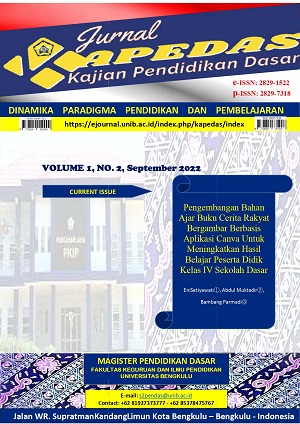Main Article Content
Abstract
Keywords
Article Details
Copyright (c) 2022 Suwai Batul Aslamiah

This work is licensed under a Creative Commons Attribution-ShareAlike 4.0 International License.

Karya ini dilisensikan di bawah Creative Commons Attribution-ShareAlike 4.0 International License .
References
- Arikunto, S. (2016). Prosedur Penelitian Suatu Pendekatan Praktik. Jakarta: Rineka Cipta.
- BSNP. (2018). Buletin BSNP: Media Komunikasi dan Dialog Standar Pendidikan. Jakarta: BSNP.
- Daryanto & Karim, S. (2017). Pembelajaran Abad 21. Yogyakarta: Gava Media.
- Depdiknas. (2005). Undang-Undang Nomor 14 Tahun 2005 Tentang Guru dan Dosen. Jakarta: Depdiknas.
- Halimah, L. (2017). Keterampilan Mengajar (Sebagai Inspirasi Untuk Menjadi Guru Yang Excellent Di Abad Ke-21). Bandung: PT. Refika Aditama.
- Jusuf, R., Sopandi, W., Ratnawulan, A., & Sa’ud, U. D. (2018). Profil Karakteristik Ujian Nasional IPA SD Berdasarkan Taksonomi Bloom Revisi. Jurnal Visipena, 1115-1127.
- Kholifah, Hanifah, & Siagian. (2021), Analisis Soal Matematika Ujian Akhir Semester Ganjil Ditinjau dari Aspek Kognitif pada Siswa Kelas VII SMP Negeri 13 Mukomuko Tahun Ajaran 2019/2020, Jurnal Penelitian Pembelajaran Matematika Sekolah, 8 (1), 99-110.
- Moleong, L. J. (2017). Metode Penelitian Kualitatif. Bandung: PT. Remaja Rosdakarya.
- Rahmadhani, Y. (2021). Analisis Kualitas Butir Soal Ujian Sekolah Mata Pelajaran IPA Berdasarkan Dimensi Pengetahuan Faktual dan Konseptual Ditinjau dari Konten dan Konteks, Jurnal Pembelajaran dan Pengajaran Pendidikan Dasar, 4 (1). 1-12.
- Sukmadinata, N.S. (2011). Metode Penelitian Pendidikan. Bandung: Remaja Rosdakarya.
- Sutisna, A., & Hesya, A. F. (2019). Metode Pembelajaran di Era Milenial. Bandung: Manggu Makmur Tanjung Lestari.
- Wijaya, A., Eresti, A., Despa, & Walid, A., (2019), Analisis Butir Soal Persiapan Ujian Nasional IPA SMP/MTS Tahun 2018 Sampai dengan 2019 Berdasarkan Taksonomi Bloom, Jurnal Pendidikan IPA, 9 (2), 57-63.
References
Arikunto, S. (2016). Prosedur Penelitian Suatu Pendekatan Praktik. Jakarta: Rineka Cipta.
BSNP. (2018). Buletin BSNP: Media Komunikasi dan Dialog Standar Pendidikan. Jakarta: BSNP.
Daryanto & Karim, S. (2017). Pembelajaran Abad 21. Yogyakarta: Gava Media.
Depdiknas. (2005). Undang-Undang Nomor 14 Tahun 2005 Tentang Guru dan Dosen. Jakarta: Depdiknas.
Halimah, L. (2017). Keterampilan Mengajar (Sebagai Inspirasi Untuk Menjadi Guru Yang Excellent Di Abad Ke-21). Bandung: PT. Refika Aditama.
Jusuf, R., Sopandi, W., Ratnawulan, A., & Sa’ud, U. D. (2018). Profil Karakteristik Ujian Nasional IPA SD Berdasarkan Taksonomi Bloom Revisi. Jurnal Visipena, 1115-1127.
Kholifah, Hanifah, & Siagian. (2021), Analisis Soal Matematika Ujian Akhir Semester Ganjil Ditinjau dari Aspek Kognitif pada Siswa Kelas VII SMP Negeri 13 Mukomuko Tahun Ajaran 2019/2020, Jurnal Penelitian Pembelajaran Matematika Sekolah, 8 (1), 99-110.
Moleong, L. J. (2017). Metode Penelitian Kualitatif. Bandung: PT. Remaja Rosdakarya.
Rahmadhani, Y. (2021). Analisis Kualitas Butir Soal Ujian Sekolah Mata Pelajaran IPA Berdasarkan Dimensi Pengetahuan Faktual dan Konseptual Ditinjau dari Konten dan Konteks, Jurnal Pembelajaran dan Pengajaran Pendidikan Dasar, 4 (1). 1-12.
Sukmadinata, N.S. (2011). Metode Penelitian Pendidikan. Bandung: Remaja Rosdakarya.
Sutisna, A., & Hesya, A. F. (2019). Metode Pembelajaran di Era Milenial. Bandung: Manggu Makmur Tanjung Lestari.
Wijaya, A., Eresti, A., Despa, & Walid, A., (2019), Analisis Butir Soal Persiapan Ujian Nasional IPA SMP/MTS Tahun 2018 Sampai dengan 2019 Berdasarkan Taksonomi Bloom, Jurnal Pendidikan IPA, 9 (2), 57-63.
